
MAY CONTAIN NUTS

Search Shorpy
SHORPY ART

Framed or unframed, desk size to sofa size, printed by us in Arizona and Alabama since 2007. Explore now.
Join and Share
Ad-Free Shorpy
Shorpy is funded by you. Patreon contributors get an ad-free experience.
Learn more.

Recent comments
- Robie House Roof(s)
- There is an interesting novel set here.
- I Was In Berlin
- Pronunciation
- Shell of a Shell
- Never been there but
- BUR-lin
- Hand-made smokes
- Birthplace of Tupperware, or at least its inventor
- Pulp
- Remarkably unchanged in 84 years
- The church is still there ...
- Talk about a smoke show
- Electric Hansom Cab
- I wondered the same thing.
- The location in 2009
- Pill Pusher
- Roll your own
- Rugged and real!
- Civil War history
- Early EV?
- A Charles Purcell - Mama Cass Connection
- Uncle SAAM
- Obfuscation
- One Chocolate Soldier rode away
- Victor Marquis de la Roche
- The Little House Across Way ...
- Vanderbilt Gates
- Vanderbilt Mansion
- You can still see that gate
Member Photos
The Shorpy
Printporium
Printporium
Search Shorpy
Search results -- 30 results per page
- Theta Pi Pastels: 1910
- ... School held their spring luncheon meeting at the Shoreham Hotel yesterday. The gathering took place in the hotel's palm court, with an afternoon of bridge following the luncheon. About ... Posted by booboogbs - 02/22/2015 - 5:03pm -
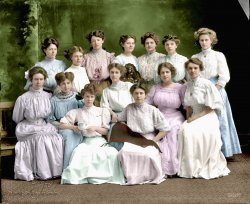
- The Boomerang: 1963
- ... into the in-ground pool. Very cool. The newer part of the hotel features gas fireplaces in every room, and private balconies. I think it ... Posted by seri_art - 12/17/2008 - 6:44pm -
![The Boomerang: 1963 Winter 1962-63 in Aspen, Colorado. Boomerang Lodge, designed by owner Charlie Paterson, a Frank Lloyd Wright-trained architect (and ski instructor). The vehicle on the left is a Cadillac hearse used as a lodge limo! View full size.
Heated Pool ... Well, I certainly hope so!
IcebikeWhat a dedicated cyclist!
VintageNice grouping of old cars--the blue Pontiac by the Ford is very nice.
[Those are new cars! - Dave]
Motel Hell . . . oI'll take a two-way ticket in the Lodge-Limo if you don't mind.
Politically correctI'm no fan of 60's architechiture but even those that are must have to admit how ugly this building truly is. So few structures of this time period have been saved (thankfully) and I'm betting that even in the ever correct Aspen, this one is gone. Better to concentrate on saving the beautiful buildings from earlier in the century that are now threatened.
When in AspenI've stayed at the Boomerang many times on business, and it is wonderful. There's a rec room in the basement that has a window looking out into the in-ground pool. Very cool. The newer part of the hotel features gas fireplaces in every room, and private balconies. I think it is a bargain, especially for Aspen.
The BoomerangYou can see the rec room window to the pool in another photo in this Aspen winter 62-63 series. Alas, time marches on and Charlie sold the Boomerang and the lot across the street a few years ago. The two sites whose links are below describe the new version that's in progress. It seems to be a condominium leaseback arrangement but I'm not clear about it. The first site says, "To honor Aspen's past, The Boomerang's 'East Wing' will retain its historic charm. Originally sketched by Charlie Paterson while studying at Taliesin West, the breakfast lounge remains as it was - with its walls and fireplace of rustic concrete and windows arranged for maximum openness. Renamed the Paterson Room, it is a tribute to Aspen's past". We'll see...
http://www.newboomerang.com (good history section here)
http://boomeranglodge.com
(ShorpyBlog, Member Gallery, Cars, Trucks, Buses)](https://www.shorpy.com/files/images/s_8abfu9skt1886_std.thumbnail.jpg)
- Company Store: 1940
- ... the principal mercantile company, the hospital and the hotel." Photo by Russell Lee for the Farm Security Administration. View full ... Posted by Dave - 08/10/2018 - 12:23pm -
![Company Store: 1940 Spring 1940. "Store in Bisbee, Arizona. Phelps-Dodge practically owns this town: the copper mines, the principal mercantile company, the hospital and the hotel." Photo by Russell Lee for the Farm Security Administration. View full size.
The winner is ... ?I remember visiting this town in the mid-'70s and thinking how picturesque it looked. Within the space of a few years, however, things grew ugly. As copper prices dropped, Phelps Dodge began cutting its work force, resulting in a harsh, violence-filled strike. The town was literally torn apart by the situation, and many lives affected. At the end, the Company declared it was getting out of the copper business in Arizona, and closed the mine, leaving the town with no viable employment. I remember seeing the news stories at the time - a picture of a now-unemployed miner holding a sign -- "WE WON!" I'm glad the town has had a resurgence of tourism and artist colony.
[The Bisbee mines closed in 1974. The strike you're thinking of was in 1983, 170 miles away at the Phelps-Dodge open pit in Morenci, which is still in operation. Also, probably not "literally" torn apart, unless there was an earthquake or tornado! - Dave]
Bisbee Big BoxThe Streamline Moderne store (designed by Del Webb in 1939) still stands as a sort of shopping and dining arcade, but the giant building behind it is gone. What was it?
Big Box StoryThe big box building was a warehouse for the Phelps Dodge Mercantile. It was built prior to 1917, as it can be seen in photographs from the 1917 I.W.W. strike and subsequent Bisbee Deportation. It survived the 1938 fire that destroyed the previous Phelps Dodge Mercantile, which led to the construction of this new Streamline Moderne building. It was razed sometime between 1951 and 1960 and became a parking lot. Many more photos and information of Bisbee can be found at the Bisbee Mining and Historical Museum website.
Yesterday's tomorrows todayThe current street view seen in the earlier comment shows why surviving Streamline Moderne buildings need to be painted white as designed. The earth tone craze doesn't suit them at all.
Subway Street?Think they ever had a subway there?
[The Subway is the drainage channel that goes under the street. Once you get to the store, Subway turns into Tombstone Canyon Road. - Dave]
Still ThereThis page has a recent shot of the Mercantile building. It looks less grand than the 1940 view, but it's still recognizable.
Public transportation warThe building at the end of the street has a "Greyhound" sign on its frontispiece. On the same building there is a board saying: "Next time, try the train and BE SAFE". A message signed by Southern Pacific.
Part of Phelps DodgeThe building behind the store in question was also part of Phelps Dodge at least according to the picture posted from the back, you can see the name on the building behind the Kodak lettering. Offices maybe?
[Um, that's not "the building behind the store." That IS the store. Both views are from the front. That's the same sign in both photos. - Dave]
(The Gallery, Mining, Russell Lee, Small Towns, Stores & Markets)](https://www.shorpy.com/files/images/SHORPY-8b24857a1_Bisbee_AZ.thumbnail.jpg)
- Anytown, USA: 1940
- ... suppose, do you, that we're looking at the same Brown's Hotel as that mentioned in the '40s standard "Atchison, Topeka, and Santa Fe"? ... and Trampas ever shot pool here?
I doubt this Brown's hotel was mentioned in the song, "Atchinson, Topeka, and the Santa Fe," since ... Posted by Dave - 02/12/2018 - 7:56pm -
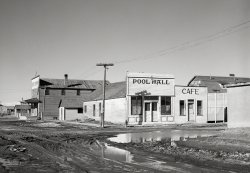
- Aerial Washington: 1911
- ... left-center across Pennsylvania Avenue from the Raleigh Hotel under construction; the Agriculture Department greenhouses in the ... theater with porthole just above the scaffolding atop the hotel under construction.
(The Gallery, D.C., DPC, Railroads, Stores & ... Posted by Dave - 04/09/2014 - 1:24pm -
![Aerial Washington: 1911 Circa 1911. "Washington from Washington Monument." Points of interest in this first installment of a six-segment panoramic view include B Street (today's Constitution Avenue), running diagonally from the Potomac Electric powerhouse at lower left; Louisiana Avenue, branching off in the general direction of Union Station at upper right; the Old Post Office and its clock tower at left-center across Pennsylvania Avenue from the Raleigh Hotel under construction; the Agriculture Department greenhouses in the foreground with a corner of the Smithsonian "National Museum" at far right, just below Center Market; Liberty Market at upper left, below what looks to be a vast tent encampment; and, at right-upper-center, the Pension Office north of Judiciary Square and the District Court House. 8x10 glass negative, Detroit Publishing Co. View full size.
"Tents"All those tents are actually slate turret roofs on top of rowhouses. Very typically, a pyramid shaped slate turret would top off the projecting bay of a DC rowhouse. All four sides would have been slated. Slate, because of its mineral content (lots of mica) can be very reflective at certain angles, hence the white appearance.
[Conical was also popular. - Dave]
SurprisingSurprising lack of motorized vehicles for ca. 1911.
[Here are seven. - Dave]
Cargo TramNow there's something I had never really thought of: street cars for freight; a forerunner of today's semi-rigs I suppose. There's one being loaded/unloaded in front of the lumber yard.
First of six?Great! Bring them on!
Kann's Busy Corneraka Kann's Department Store. A good history of the life and death of the buildings can be found here.
[More here. - Dave]
+86Below is the same view taken in December of 1997. (Please excuse my still-limited scanning talents - this was before I switched to digital.)
DC in 1911What a great photo. More of these buildings than one would think are still there. The "District Court House" south (right) of the great Pension Building on Judiciary Square is the original DC City hall, started in 1820. After a several-years-long redo, it now houses in grand style the DC Court of Appeals (the state supreme court for the District.) Peeking around the office building to the left of the City Hall on 5th Street NW is the then-new US Court of Appeals building, which housed what is now the US Court of Appeals for the DC Circuit until 1952, when it moved to the new federal courthouse on Constitution Avenue (now the Prettyman Courthouse.) The old US Court of Appeals building now houses the US Court of Appeals for the Armed Forces, on which I am privileged to sit. It is an exquisite little building, quite well-preserved, with many of its original furnishings.
Ford's TheaterI had a thought that Ford's Theater was off in this general direction, so I took a look. Not being all that familiar with D.C. I'm wondering if that is the peak of the theater with porthole just above the scaffolding atop the hotel under construction.
(The Gallery, D.C., DPC, Railroads, Stores & Markets, Streetcars)](https://www.shorpy.com/files/images/SHORPY_4a10391a.thumbnail.jpg)
- Red Channels: 1959
- ... summer Olympics in Moscow stayed at the enormous Rossiya hotel, just off Red Square. Which had no TVs in the rooms, just the old wooden ... Posted by Dave - 06/28/2014 - 11:57pm -
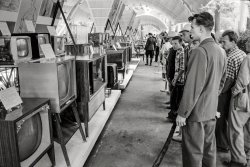
- Stop-Stop & Go-Go: 1919
- ... equipped with umbrella and rearview mirror. The Willard Hotel and U.S. Treasury play supporting roles in this Harris & Ewing glass ... Posted by Dave - 05/06/2014 - 9:07am -
![Stop-Stop & Go-Go: 1919 Circa 1919. "Traffic officer at 14th Street and Pennsylvania Avenue." Before stoplights in the District of Columbia, there was the "Go-Go" traffic sign equipped with umbrella and rearview mirror. The Willard Hotel and U.S. Treasury play supporting roles in this Harris & Ewing glass negative. View full size.
ObsolescenceA hard working family man long since replaced by a few million electrons.
As seen previously on ShorpyWe've seen this same location (from other occasions, when the umbrella was up & the officer on duty had no ear coverings) previously on Shorpy here and here.
[This one has a new & improved sign, with mirror and bigger letters. - Dave]
Early Selfie"Looking good, my man, looking good."
Origination of the TermWhen one stands in one place too long one can become flat footed.
Mirror, Mirroron the pole, who's the fairest gendarme of them ole?
Prototype traffic signal controllerIt's easy to see how the mirrored platform was the direct predecessor to early street embedded treadle actuated automated traffic light control systems. Subsequent developments however seem bent on removing any resemblance to the original, with things like ultrasonic, street imbedded induction loop, pedestrian demand button and who knows what other kind of sensor/actuators.
Improvement?Somehow I think traffic might have flowed better with this guy at the intersection than it does today.
Go-Go BootsApparently the fashion was started by men and required a 'platform' heel.
Wooden palletStanding on the wood will help his joints, especially if he has 8 hours of duty a day at that post.
[It would also keep his feet warm. The ground is a heat sink. - Dave]
(The Gallery, Cars, Trucks, Buses, D.C., Harris + Ewing)](https://www.shorpy.com/files/images/SHORPY-29851a.thumbnail.jpg)
- Kitchen of Tomorrow: 1954
- ... exhibit for the GM Motorama at the Waldorf-Astoria Hotel in New York." Large-format color transparency. View full size.
... Posted by Dave - 07/12/2018 - 8:04pm -
![Kitchen of Tomorrow: 1954 1954. "Harley Earl, General Motors Vice President of Design, in Frigidaire's 'Kitchen of Tomorrow' exhibit for the GM Motorama at the Waldorf-Astoria Hotel in New York." Large-format color transparency. View full size.
King FinBack in 1956, had I known he was the one responsible for tailfins on cars, I would have worshiped this man. My father took me to a GM Motorama at San Francisco's Civic Auditorium in 1955 or 1956; I wish my memories were stronger, but what remains is of being in a wonderland.
Back to the FutureIt's amazing how modern that kitchen looks, even today. Like something out of the Ikea catalogue.
Modern but flimsyEverything about that kitchen looks like it would fall apart with real use. Sure, it looks nice, but a few teenagers would destroy it in a month. And what's with the color swatches next to what looks like a microwave?
What's he doing there?Even before I read the caption, I thought, "That's Harley Earl - what's he doing in a kitchen?" Like Archfan, I see this being like a modern kitchen. On the left we see a water dispenser (though not incorporated into the refrigerator), a small color TV displaying a recipe, and a fully instrumented electric range. And I'm thinking that the brushed gray doors toward the right might be refrigerated cabinets.
[The "color TV" is some sort of microfilm recipe reader. You can see the "horizontal refrigerator" in action in this video. - Dave]
At the time, most of the automakers owned appliance makers. Besides GM's Frigidaire, there was Philco, owned by Ford, and Kelvinator, owned by American Motors. Chrysler's Airtemp made home air conditioning, and even International Harvester made refrigerators and freezers for awhile, targeting the farm families that bought their tractors and implements.
Kitchen Design?Looks more like his GM corporate office.
The ManA lot of people have been called "The Man". Harley Earl WAS The Man.
TimelessIt still looks modern today, in my view. And what an upgrade from just 30 years prior.
FormicaThe cabinets remind me of the kitchen table we bought in 1955 when I came out of the Army. The same ugly Formica although we thought it was quite nice at the time.
(The Gallery, Kodachromes, Kitchens etc., LOOK)](https://www.shorpy.com/files/images/SHORPY-1nnnnu1.thumbnail.jpg)
- Peachtree Street: 1957
- ... also got $2 a week for bus fare. We walked to and from the hotel and classroom (both a little farther up Peachtree Street) and bought a ... Posted by prrvet - 03/21/2018 - 4:53pm -
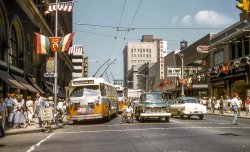
- Milk and Cuties: 1951
- ... part of Santa Barbara, close to the five-star Biltmore Hotel.
(Kodachromes, LOOK, Pretty Girls, Swimming) ... Posted by Dave - 02/26/2014 - 1:52pm -
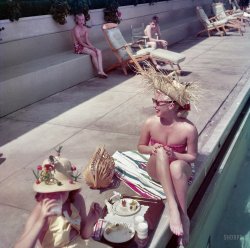
- The Pamphlet: 1922
- ... "[HO]TEL [...]NERT". A bit of research reveals there was a Hotel Rennert in Baltimore in the narrow block bounded by Saratoga, Liberty, ... intersection of Clay & Liberty. A 1903 photo of the hotel's west façade -- detail below -- is an exact match for the dome seen ... Posted by Dave - 04/11/2015 - 10:26am -
![The Pamphlet: 1922 Easter and Holy Week in Washington, D.C., 1922. "Group of pages." Plus an usher. 4x5 inch glass negative from the Harris & Ewing Collection. View full size.
Huge buttonsFor her hat, tasseled belt, collar clip, two-tone brogues with low heels, and, of course, those outsized buttons, my vote for Most Stylish goes to the page second from the right.
Chain beltMy vote is for the sweet gal wearing the chain belt and criss cross shoes. Love her smile and her hair. All of these young ladies are lovely.
GrandmothersThis photo was taken the week that my father was born, so these girls are of my grandmother's generation. Gives me a different perspective, since I only knew my grandmother as an "older" woman, but she was once a young girl, too.
Lovely laceI remember this generation of women wore lace collars their whole lives. My grandmothers and great-aunts donned them at formal events until their passing in the 70's. I miss that beautiful fabric.
Charm CityI'm certain that this photo was taken in Baltimore, not in Washington.
Behind the heads of the two women at right, we see a painted sign reading "[HO]TEL [...]NERT". A bit of research reveals there was a Hotel Rennert in Baltimore in the narrow block bounded by Saratoga, Liberty, Clay, and Sharp Streets.
A handsome dome topped its southwest corner at the intersection of Clay & Liberty. A 1903 photo of the hotel's west façade -- detail below -- is an exact match for the dome seen above & behind our pages. The dome's balcony and the pointed pediment next to it also match, further confirming the location. Thus, the cameraman was looking west, capturing the Rennert's narrow southern façade.
The women in the photo seem to be standing on a balcony or terrace on the south side of Clay Street between Sharp and Charles. Perhaps they came from St. Paul's Church, which lies one block to the east across Charles St.
(The Gallery, D.C., Harris + Ewing)](https://www.shorpy.com/files/images/SHORPY-42092a.thumbnail.jpg)
- Federal Triangle: 1935
- ... new The photographer took this from the "new" Raleigh Hotel (constructed after the original was razed in 1911) on the northeast ... Post Office is now closed and being converted to a luxury hotel by Donald Trump. In the 1960s the parking area in front of the Old PO was ... Posted by Dave - 10/21/2014 - 5:36pm -
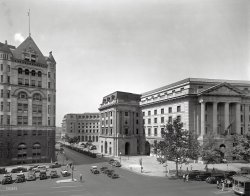
- Piano Prodigy: 1922
- ... she was found dead under water in a bathtub at the Drake Hotel on July 23, 1959. She was known as The Baroness Evelione Taglione Kelly. ... Posted by Dave - 03/08/2013 - 5:30am -
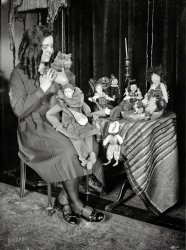
- Sic Transit: 1910
- ... the avenue the site being excavated is now occupied by the Hotel Pennsylvania, opened in 1919 and designed by the same architectural firm ... Posted by Dave - 11/08/2019 - 10:44am -
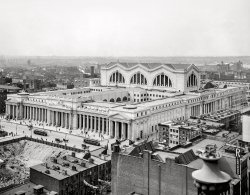
- Motel Moderne: 1962
- ... circa 1962. Our second look at the Martinique Motor Hotel, last seen here from different spatial and seasonal vantages. 4x5 ... Posted by Dave - 06/04/2022 - 12:41pm -
![Motel Moderne: 1962 Columbus, Georgia, circa 1962. Our second look at the Martinique Motor Hotel, last seen here from different spatial and seasonal vantages. 4x5 inch acetate negative. View full size.
Late 1950s Cars1957 Cadillac; 1959 Ford station wagon; 1960 Ford; ? Lincoln Continental; Chevy Corvair; 1957 Chevy; '58 Mercury station wagon; '58 Chevy; maybe a Cadillac behind the bushes; '56 Oldsmobile; '59 Chevy station wagon.
[The Lincoln would be a 1961 or later model; that's a 1959 Mercury wagon; the car next to the '58 Chevy is a 1962 Chevrolet. - Dave]
Motel? More like school!The architecture closely resembles my high school (also built in the 60s). The school had a few more windows -- not many, but a few.
The upper 48 ?The corner building is apparently a later addition (and explains the differing info on postcards). How much later I guess we can judge by the cars ... who knew "dating assist" was an AAA service ?
(The Gallery, Cars, Trucks, Buses, Columbus, Ga., News Photo Archive)](https://www.shorpy.com/files/images/SHORPY-1678.thumbnail.jpg)
- Into the Mystic: 1940
- ... the shore location, I'm guessing a vacation boarding house/hotel.
[The house has one front door. Those other apertures are windows. ... Posted by Dave - 04/25/2022 - 11:17am -
![Into the Mystic: 1940 November 1940. "Houses, late afternoon. Mystic, Connecticut." The moldy manse last seen here. Acetate negative by Jack Delano for the Farm Security Administration. View full size.
Boarding house or multi-familyYou can see in both this and previous photos there are multiple entrances to the front of the structure. That tells me it was either a multi-family or a boarding house. Given the shore location, I'm guessing a vacation boarding house/hotel.
[The house has one front door. Those other apertures are windows. - Dave]
Lower your maintenance cost!Someone needs to leave a business card advertising Vinyl Siding. Colors available in black and white.
Much of what I say is trueIn the link to the Josephine Dickenson collection, the history of the house is given as follows: Morgan House, ca. 1930. The house, (187?), 25 Broadway at East Main Street, was the residence of Christopher Morgan in the 1920s. The house appears on the 1879 map of Mystic but is not shown on the 1868 map. In 1868, the property was owned by Charles Mallory. The house was razed in the 1940s or 1950s and an A&P Supermarket built on the property. This house was a good example of the Second Empire style.
DFP is adding:
They say on eerily calm nights the figure of young Miss Morgan, dressed all in white and with white skin and hair comes out of the Mystic Congregational Church. She floats down the steps and begins walking towards this house. The streetlights go out. She stops and, with her hand, places a kiss on the base of the monument to Civil War Union Soldiers. When she gets to where her family's home once stood, she turns and floats up the steps that are no longer there and disappears. Sometimes as she walks you can hear an organ play. They never could get the bloodstains off the organ keys; and they used Bon-Ami.
Click to embiggen
Gone With The WindAlready missing in this view, but present in some older historical photos of the home, are the lovely rows of mature elm trees that CT and other New England states were famous for. Lost in Mystic (and elsewhere) to the Hurricane of 1938 and adding to the ravages at that time of Dutch Elm Disease. More's the pity.
(The Gallery, Gas Stations, Jack Delano, Small Towns)](https://www.shorpy.com/files/images/SHORPY-8c03723a.thumbnail.jpg)
- Midcentury Manhattan: 1950
- ... two towers further to the right is the Waldorf-Astoria Hotel.
One building that's a bit harder to identify is the squarish ... Posted by Dave - 06/10/2013 - 10:19am -
![Midcentury Manhattan: 1950 March 14, 1950. "New York City views. Manhattan skyline from City Hospital." Large-format acetate negative by Gottscho-Schleisner. View full size.
East River EnclaveCity Hospital, the site from which this was photographed, was on Welfare Island, sandwiched between Manhattan and Queens. The hospital was also known at one time as Penitentiary Hospital. It was closed in 1957 and was finally demolished in 1994. Welfare Island, formerly known as Blackwell Island finally morphed into Roosevelt Island, is a now a residential district with great view of Manhattan. It lobbied the city and was granted a Manhattan Zip Code, 10044 and area code, 212. It is connected to the Manhattan from the east by an aerial tram and from the Queens side by subway and bus.
ExquisiteThe man certainly knew how to make light work to improve the shot. Breathtaking.
FDRWas it still called Welfare Island in 1950? Look how light traffic was on the East River Drive!
[Renamed Roosevelt Island in 1973. -tterrace]
New Desktop MaterialThis is just an amazingly wonderful photo. Strangely enough, the nearly-completed United Nations Building off to the left looks incredibly out of place with the other gothic and art-deco structures in New York's skyline.
Some landmarksAt far left are the smokestacks of the electric power plant that occupied the east side of First Avenue between 38th and 40th street until just a few years ago. Next is the UN Secretariat, a couple years away from completion. At the time, the UN's temporary headquarters was just across the Nassau County line in Lake Success, in a former industrial building that's now an office park. Trivia: prior to the start of construction in 1947, the UN site shown here was occupied by a slaughterhouse.
A bit to the UN's right, among the buildings of the Tudor City apartment complex, the upper part of the Metropolitan Life tower can be glimpsed. Located a mile south of the UN, it was built in 1909 and had been the world's tallest building for a few years. Moving on to the right, the Empire State and Chrysler buildings are obvious. The building in the foreground with the rounded tower and two large wings facing the camera is a (very) luxurious apartment building with a 52nd Street address known as Riverhouse. It used to have its own yacht basin on the East River, but that was lost with the construction of the FDR Drive in the 1930's. The building with two towers further to the right is the Waldorf-Astoria Hotel.
One building that's a bit harder to identify is the squarish building slightly left of center with the huge antenna on top. I believe it is the 37-story Daily News building at 220 East 42nd Street, built in 1930, as it was one of the relatively few pre-1950's buildings in Midtown with a flat roofline, and the big antenna would make sense on a newspaper's headquarters. I'm not completely sure, however.
Welfare/Roosevelt Island lacked direct road access until a bridge from Queens opened in the early 1950's. The Queensboro Bridge (now known as the Ed Koch Queensboro Bridge) ran over the island starting in 1909, but was too high above the surface for a direct exit to be feasible. Instead, the trolleys which ran across the bridge stopped at a mid-span station called the "Upside Down House," from which elevators and stairs allowed people to descend to ground level on the island. In 1930 some of the elevators were modified to accommodate vehicles, enabling ambulances to bring patients to the island's hospitals. Trolley and elevator service ended when the bridge from Queens opened and the Upside Down House was demolished around 1970.
George GershwinI cannot look at this picture without hearing "Rhapsody In Blue" going through my head, even though that magnificent song was 26 years old in 1950. Seems like every movie I ever saw about N.Y. used that musical theme.
GottschoI try to figure out what it is that makes Gottscho's photos so instantly identifiable as his own: the lighting? the subject? the New York spirit that he captures so well and transmits in his own unmistakable style? All I know is that when I go to the always-open Shorpy tab and hit Refresh and see the Gottscho image appear, my pulse quickens and I embiggen the photo with slack-jawed wonderment. (Thanks to Peter, as well, for the very fine skyline guides.)
Quiet CityThe piece of music that comes to my mind is Copland's Quiet City. http://www.youtube.com/watch?v=Gu06sqSIRdE
(The Gallery, Gottscho-Schleisner, NYC)](https://www.shorpy.com/files/images/SHORPY_5a19651u.thumbnail.jpg)
- Temple of Beauty: 1908
- ... of Woodward. In the distance is the original Pontchartrain Hotel.
AG Spalding! Those merchants vying for your trade also includes ... sign he's got hanging there!
1905? Maybe not. The Hotel Ponchatrain opened October 29, 1907 and since we can see folk in Summer ... Posted by Dave - 02/23/2017 - 11:03pm -
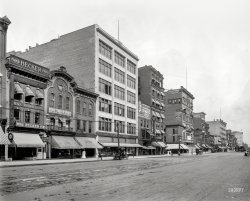
- Klassy Kamp: 1915
- ... or even reminiscent of the group pictures hanging on the hotel walls in "The Shining". Maybe there is something in the water or they ... Posted by Dave - 06/21/2018 - 10:45pm -
![Klassy Kamp: 1915 July 1915. Washington, D.C. "Klassy Kamp group." One of the many summer camps dotting the banks of the Potomac a century ago. Other views here and here. National Photo Company Collection glass negative. View full size.
Starting the day off with a bang"I thought I told you people NOT to let Irma play with the matches!"
Carry on CampingOther camps included Big Six camp, Raccar camp and Camp Ease. More information here:
Summer Camps Along Virginia Shore of the Potomac
Gangsters and a GypsyThat has to be Bonnie and Clyde upper left. That lady up top with the headscarf is trying to hypnotize me.
Something about their eyesAfter enlarging this picture, everyone in it seems to be under hypnosis or perhaps in the twilight zone, similar to a group of robots or programmed people from science fiction or even reminiscent of the group pictures hanging on the hotel walls in "The Shining". Maybe there is something in the water or they have been brainwashed, but doesn't it look just a little unnerving?
[Obviously they're trying to tell you something. WHAT IS THE MESSAGE? - Dave]
A musical groupIf they join in with the wind-up phonograph, those five variations of guitars and mandolins could make a lovely sound for what may be a July 4th celebration with the young lady preparing to light the fuse of the huge dummy firecracker -- let's hope it's a dummy!
Woodstock 1915There'll be a wild time tonight.
Racy picture for sure. Oh Baby!A female ankle. Covered with a sock. Still, hot for the times.
Fathers, watch out for the Mandolin ManA favorite story from my mother is when she was a teenager in the late 1920s. A steady visitor to her house was one Billy Bowen, along with his mandolin and two or three of his male friends.
They would sit in the front parlor with my mother, Kate, and my piano playing Aunt Rose, Aunt Helen, Aunt Marge and Grandmother Wilhelmina and talk for a while, then Billy would start to strum the mandolin and play some songs from the Gay '90s ("Who Put the Overalls in Mrs Murphy's Chowder?") to amuse my grandmother.
Who would leave as he segued into the popular tunes of the day. Now he was a very accomplished musician who could play and sing as he tried to steal kisses from Mom. Sometimes she would let him get his wish and other times she would coquettishly hold him off. My aunts, especially piano player Rose, were busy doing the same with his friends as they would sing until they kissed and continue singing afterwards. There was always someone singing and a musical instrument playing to convince Grandmother everything was on the up and up.
I always wondered if in whatever social media was popular then if the Streb Girls of Aisquith Street were known as Easy Girls.
(The Gallery, Camping, D.C., July 4, Natl Photo)](https://www.shorpy.com/files/images/SHORPY-32162u.thumbnail.jpg)
- The Winona: 1899
- Winona, Minnesota, circa 1899. "Winona Hotel." Spelled out in Edison bulbs. 8x10 inch dry plate glass negative, ... a case in the building off to the right of the former hotel, set back from the street - the Winona County Courthouse, built in 1889. ... Posted by Dave - 11/06/2017 - 2:36pm -
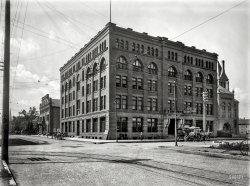
- Foot Traffic: 1942
- ... Lapidus Morris Lapidus also designed the Fontainebleau Hotel in Miami Beach - once the most glamorous of Miami Beach's hotels - which ... Posted by Dave - 09/07/2013 - 11:42am -
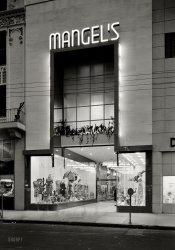
- Our Confederate Dead: 1903
- Augusta, Georgia, circa 1903. "Albion Hotel and Confederate Monument." A full view of the memorial glimpsed here ... Posted by Dave - 05/17/2014 - 9:45pm -
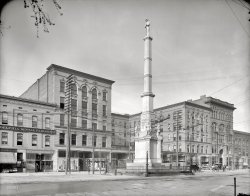
- The 24-Carrot Kitchen: 1954
- ... exhibit for the GM Motorama at the Waldorf-Astoria Hotel in New York." Flanking the Range of Tomorrow we have, on the right, the ... Posted by Dave - 11/19/2018 - 8:14pm -
![The 24-Carrot Kitchen: 1954 1954. "Harley Earl, General Motors Vice President of Design, in Frigidaire's 'Kitchen of Tomorrow' exhibit for the GM Motorama at the Waldorf-Astoria Hotel in New York." Flanking the Range of Tomorrow we have, on the right, the Rotisserie Oven of Next Wednesday; on the left, stowed in the down position, is an "Electronic Oven," which is what they called microwaves back in the day. Color transparency by Arthur Rothstein for Look magazine. View full size.
Frigidaire FlairWhen I bought my house 22 years ago I thought that bizarre oven/stove combo would be the first thing to go, but I'm still using it! Previous owners were kind enough to leave both pics of the house from a Better Homes article from 1941 and the original brochure for the stove, among other things. The lady on the cover of the brochure is wearing a dress, high heels, and a CROWN while using the fancy new appliance! One major downside is the interiors of those ovens are chrome and therefore nearly impossible to clean.
BewilderedMr. Earl looks ... uncomfortable.
"What do you expect me to do with these carrots? I'm a car designer."
Always wondered what motivated GM to get into appliances.
[Zillions of dollars in profits? - Dave]
And here it isCourtesy of Google Books, here's an article on the Motorama kitchen, from the April 1954 issue of Popular Science.
Paging Jackie GleasonWe desperately need "The Chef of the Future" to complete this scene.
Visine, pleaseGod bless him, but who decided Harley Earl should be in this shot? Dude looks like he tied on a few the night before. Your modeling days are behind you, buddy.
1950s ProphecyTomorrow is like today only in stainless steel.
A gadgety timeIn the early 1960s my parents renovated their 1920s Colonial home outside of Detroit. The kitchen especially received much attention with a fresh coat of orange paint (so much orange) and a space-age Frigidaire Flair double oven with pull-out cooktop.
Futuramic CarrotsHarley Earl was fixated on the future, at least in his own areas of operations.
I believe he is scrutinising the carrots, trying to visualize the carrot of 1957 if GM should make the logical move from stoves to vegetables.
Should it be straightened, or should we just make the curve more controlled? Fins?? and those leaves desperately need some organization!
(The Gallery, Kodachromes, Kitchens etc., LOOK)](https://www.shorpy.com/files/images/SHORPY-12349u1.thumbnail.jpg)
- A Fan in Every Room: 1938
- ... wave.
Pittsburgh's Roosevelt The Roosevelt Hotel (named for Teddy, not Franklin) opened in 1927 and closed in 1972. It had ... Stadium, Art Rooney ran his NFL football team from the hotel. It still stands today as a mixed-use building with 109 apartments and ... Posted by Dave - 12/14/2018 - 7:18pm -
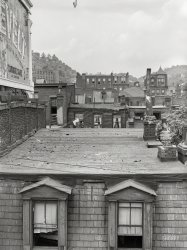
- Night Life: 1940
- ... of the time, an awful lot of his were just shot out his hotel room windows.
[John Vachon shot more than 11,000 exposures for the FSA. Less than one percent were "out his hotel room windows." - Dave]
Trouble with a capital "T" ... ... Posted by Dave - 12/15/2019 - 12:27pm -
![Night Life: 1940 November 1940. "Lincoln, Nebraska." Acetate negative by John Vachon. View full size.
Good Times Rollin'With the exception of the Ford (second from right), all of the cars photographed here are practically new. One has to wonder if a similar present-day scene would reflect a comparable degree of apparent prosperity.
Where drama meets detachmentAnother exquisitely haunting (and Hopper-esque) shot by Vachon, master of composition and light.
It's cold outside?I know it was late Fall when he shot this area, likely cold and wet, but seems like compared to other government photogs of the time, an awful lot of his were just shot out his hotel room windows.
[John Vachon shot more than 11,000 exposures for the FSA. Less than one percent were "out his hotel room windows." - Dave]
Trouble with a capital "T"... and that rhymes with "P" and that stands for Pool! The first big step on the road to the depths of degradation -- at least according to Professor Harold Hill!
What a terrific picture.
(The Gallery, Cars, Trucks, Buses, John Vachon)](https://www.shorpy.com/files/images/SHORPY-8c18315a.thumbnail.jpg)
- ColumBus: 1943
- ... In my youth, WCH still had two downtown hotels, the Hotel Washington, as shown, and the Cherry Hotel, which Esther Bubley must have been standing before when she snapped this ... Posted by Dave - 09/07/2014 - 5:21pm -
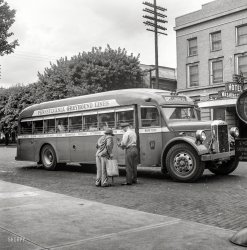
- Mansion House Staff: 1900
- ... Poland Spring, Maine, circa 1900. "At the Mansion House -- hotel staff." 8x10 inch dry plate glass negative, Detroit Publishing Company. ... Posted by Dave - 09/17/2012 - 10:45am -
![Mansion House Staff: 1900 Poland Spring, Maine, circa 1900. "At the Mansion House -- hotel staff." 8x10 inch dry plate glass negative, Detroit Publishing Company. View full size.
Keep a straight face, he's the bossThe diversion may be one of the young Ricker family tripping over their billfold, a rich kid no doubt, (unlike tterrace!)
more on The Mansion at Poland Spring here.
One Lucky GentlemanI wonder what the diversion is to their right. Looks like it could be amusing. This type of photograph is to me most fascinating because of the variety of faces and expressions.
Grass stainsOn those white dresses: must have been a constant problem. And those high collars in the summer, along with the long sleeves, must have made for plenty of sweat. (Although ladies didn't sweat then; they "glowed".) I wonder what they're looking at to their right, just outside of camera range.
Off to their rightGiven the setting, I conjecture that upon the photographer's "Watch the birdie!" some looked at the wrong one.
A Little Less Starch Please!That guy in the middle looks like both he and his clothes got the full starch treatment.
[That may be a celluloid collar and shirt front or "dickey." - tterrace]
Uh Oh !It looks like two of these women are wearing the same dress. That must have been awkward.
A William Dean Howells fanI must thank you for these photos. Howells wrote a number of books set in the genteel milieus of the large resort hotels in New England, which flourished so magnificently at the turn of the 20th Century. These portraits give actual faces and costumes to the staff at those proud palaces of leisure and relaxation.
(The Gallery, DPC)](https://www.shorpy.com/files/images/SHORPY_4a20269a.thumbnail.jpg)
- Pennsylvania Avenue: 1919
- ... Behind it in the picture you can see the Raleigh Hotel, which alas was demolished in 1964.
Doughboy Notice the soldier on ... Posted by Dave - 08/16/2012 - 10:23am -
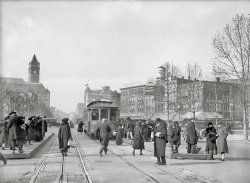
- Inner Sanctum: 1937
- ...
That's our room My wife and I stayed in that hotel about 20 years ago. Our room was the one just to the left of the entrance ... Posted by Dave - 06/29/2013 - 12:54pm -
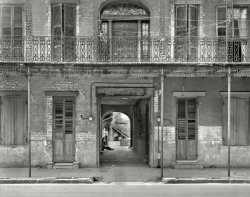
- Copley Plaza: 1912
- Boston, Massachusetts, circa 1912. "Copley Plaza Hotel, Copley Square." 8x10 inch dry plate glass negative, Detroit Publishing ... Posted by Dave - 01/05/2019 - 1:44pm -
![Copley Plaza: 1912 Boston, Massachusetts, circa 1912. "Copley Plaza Hotel, Copley Square." 8x10 inch dry plate glass negative, Detroit Publishing Company. View full size.
Tag on that "cool roadster"That black-on-white license plate on the cool roadster is a 1912 Rhode Island dealer's license number 1. Collectors would pay four-figures for that today.
That Car!What make is that automobile in the foreground? It almost looks like an early model Jeep. I wonder if any Shorpy fan can identify it and what year it was manufactured?
Granddad worked hereUntil his passing in 1960, my grandfather was maître d' in the Merry-Go-Round Room on the first floor just inside the righthand entrance. The lounge closed for a day in his honor.
This grand old lady still stands.
Still there todayPretty much everything else is gone, 'cepting the BPL (behind the trees) and Trinity Church (behind the photog).
Cool roadsterI love the car at the curb. Probably hard to identify it here, and the bolt-on split windshield is something I've never seen before in my 40+ years in the antique car hobby.
[That's some sort of fabric snap-on shroud. - Dave]
Found a bird!I’m always trying to spot birds in these old photos whether they are in trees, on wires or on buildings. I have yet to find many in my several years of looking. I think Dave said it was mostly due to shutter speed? Anyway, I finally spy a pigeon on the grass in front!
1912 Rhode Island License Plate Number 11912–17
Black numbers on white porcelain plate;
Design .............. vertical "RI" at left
Slogan .............. none
Serial format ...... 12345
1 to approximately ... 35000
Rhode Island reused numbers from earlier expired registrations. The reason being they did not want to exceed the 99,999 numbering scheme limit. They did exceed that limit in 1913.
That said, this is the first 1912 registration. suggesting the auto is 1912 or earlier vintage.
The auto at the curbOut on a limb. It looks like the 1912 Thomas Flyer Model MC 6-40 Roadster. radiator and spare tire mounts are similar.
Cambridge FrontThe leatherette and isinglass windshield supported by brass rods was most likely made by a company in Cambridge, Massachusetts. Known as "Cambridge Windshields," they were mostly used on sporting type cars.
Also note that the car appears to have Rhode Island license plate number 1.
(The Gallery, Boston, Cars, Trucks, Buses, DPC)](https://www.shorpy.com/files/images/SHORPY-4a24556a.thumbnail.jpg)























